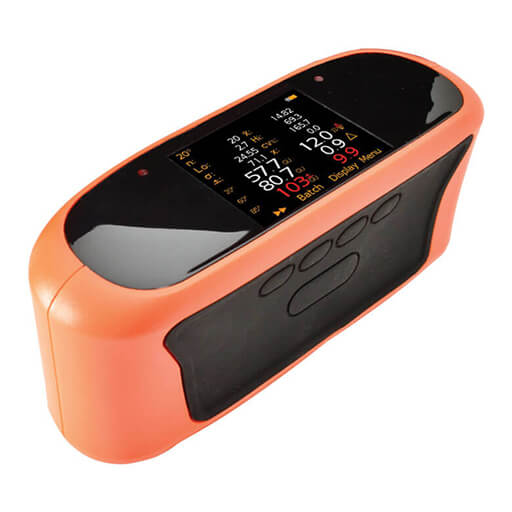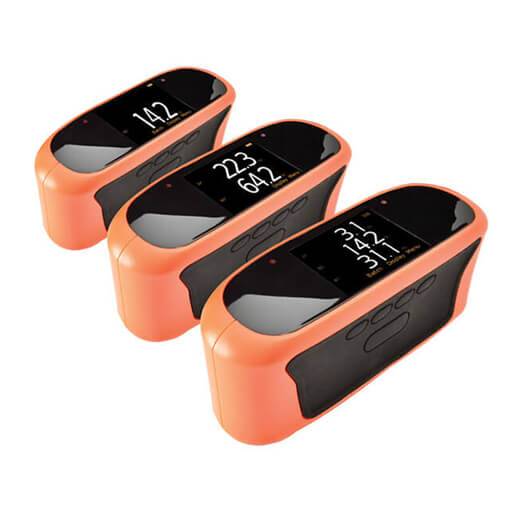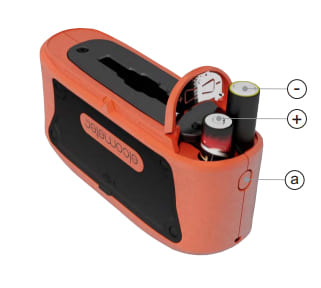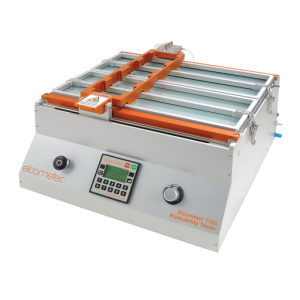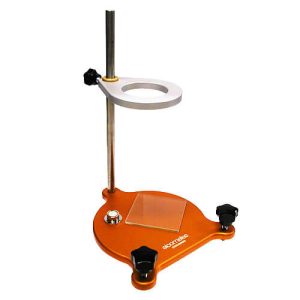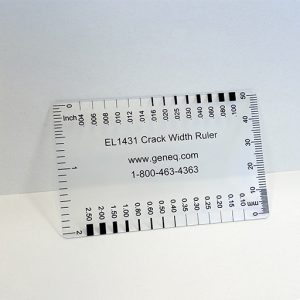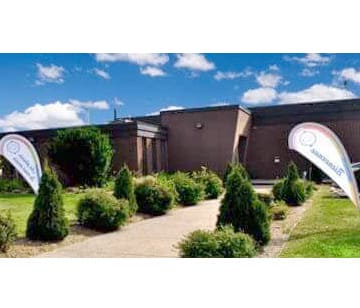The glossmeters are small, robust, and ergonomic, the Elcometer 480 range of gloss meters have been designed to exceed the demands of the industry today.
Visual appearance can determine a person’s perception of a product. Perception is subjective. A key measurement parameter used to define and quantify a product’s overall visual quality is gloss.
Combining easy to use, multi-lingual menu structures with exceptional repeatability, reproducibility & accuracy, the Elcometer 480 provides users with the best in class handheld gloss measurement.
Reliably measure & record gloss, percent reflectance & haze, on any material, including paint, plastic, ceramic, or metal.
The Elcometer 480’s rapid LED technology accurately measures up to 3 angles at the same time at a rate of 10 readings per second. Measurements can be instantly transferred to PC, iPhone, AndroidTM, or other mobile devices via USB or Bluetooth®.
Using the ElcoMasterTM software, professional reports for glass and other appearance measurements can be quickly generated. Alternatively, gloss readings can be combined with other key measurement parameters such as coating thickness, adhesion and oven temperature profile – within the same software package.
Gloss is measured by directing a constant intensity light beam, at a fixed angle, onto the test surface and monitoring the amount of reflected light from the same angle. This specular reflectance is measured using a gloss meter.
Gloss is measured by directing a constant intensity light beam, at a fixed angle, onto the test surface and monitoring the amount of reflected light from the same angle. This specular reflectance is measured using a gloss meter. Different surfaces require different reflective angles.
High Gloss
Surfaces with brilliant or highly polished finish reflect images clearly. This distinct reflection is caused by the incident light reflecting on the surface in a specular direction.
Semi & Matt Gloss
Semi and matt surfaces reflect images less distinctly and with reduced intensity. On semi or matt surface light not only reflects in a specular direction but also is scattered causing the reflected image to appear diffused.
Choosing the Correct Angle for Gloss Measurement
Gloss measurement is based on the amount of light reflected on the surface relative to a polished glass reference standard, measured in Gloss Units (GU). The amount of light that is reflected on the surface is dependent on the angle of incidence and the properties of the surface.
Gloss is categorized as either matt, semi, or high gloss. In order to determine the most appropriate measurement angle start with a gloss meter set at a 60-degree angle of incidence.
If the result is between 10-70GU, the coating is termed ‘semi-gloss’ and should be measured using the 60degree angle. If the result is less than 10GU, the product is ‘low gloss’ and should be measured using the 85degree angle and if it is greater than 70GU, the product is known as ‘high gloss’ and should be measured using the 20degree angle.
Specifications
Gloss Range |
60° value |
Measure with |
| High Gloss | > 70GU | 20° |
| Semi-Gloss | 10 – 70GU | 60° |
| Low / Matt | < 10GU | 85° |
% Reflectance (%)
% Reflectance compares the amount of light energy transmitted and received by a gloss meter and expresses the value as a percentage. The shinier a surface is, the closer the value will be to 100%.
While the Gloss Unit (GU) scale is linear, each angle of incidence has a different measurement range; 0 – 2000GU (20degree), 0 – 1000GU (60degree), 0 – 160GU (85degree).
%Reflectance displays the measurement value as a percentage relative to the selected angle of incidence. For example, a value of 1000GU at 20degree would be express as 50%20.
Haze (HU)
Haze causes a drop in reflected contrast and causes ‘halos’ to appear around the reflected light sources, dramatically reducing the visual quality.
In accordance with ASTM D4039 haze is defined as the numeric difference between the specular reflectance at 60degree and 20degree.
This is expressed in Haze Units (HU).
This instrument complies with:
AS/NZS 1580.602.2, ASTM C584, ASTM C523, ASTM D523, ASTM D1455, ASTM D2457, ASTM D4039, ASTM D4449, ASTM D5767, ASTM E430, ASTM E2387, BS 3900 D5, DIN 67530, ECCA T2, EN 12373-11, EN 13523-2, ISO 7668, ISO 2813, ISO 13803, ISO 17025, JIS K 5600-4-7, JIS Z 8741, TAPPI T 653 (20°)
QUICK TIP:
Taking a reading: standard mode (b & t):
1. Press and hold the measure softkey for approximately 3 seconds to switch the gauge on.
2. Perform the calibration procedure if required – see Section 5 ‘Calibration’ on page 13. d
3. Place the gauge on the test surface and press the measure softkey to take a reading. A reading is displayed on the screen (for each geometry selected via Display/Display Geometry – see Section 3.6 ‘Geometry Selection’ on page8).
4 If the user has chosen to view ‘Selected Statistics’, ‘Run Chart’ or ‘Bar Graph’ – see Section 3.5 ‘Setting Up the Reading Display’ on page 6.
Pressing the softkey displays the statistics, run chart, or bar graph for each 8 individual geometry.
Download Data Sheet
Download Instruction Manual
VISIT TESTCOATINGS.CA FOR MORE ELCOMETER PRODUCTS
The glossmeters are small, robust, and ergonomic, the Elcometer 480 range of gloss meters have been designed to exceed the demands of the industry today.
Visual appearance can determine a person’s perception of a product. Perception is subjective. A key measurement parameter used to define and quantify a product’s overall visual quality is gloss.
Combining easy to use, multi-lingual menu structures with exceptional repeatability, reproducibility & accuracy, the Elcometer 480 provides users with the best in class handheld gloss measurement.
Reliably measure & record gloss, percent reflectance & haze, on any material, including paint, plastic, ceramic, or metal.
The Elcometer 480’s rapid LED technology accurately measures up to 3 angles at the same time at a rate of 10 readings per second. Measurements can be instantly transferred to PC, iPhone, AndroidTM, or other mobile devices via USB or Bluetooth®.
Using the ElcoMasterTM software, professional reports for glass and other appearance measurements can be quickly generated. Alternatively, gloss readings can be combined with other key measurement parameters such as coating thickness, adhesion and oven temperature profile – within the same software package.
Gloss is measured by directing a constant intensity light beam, at a fixed angle, onto the test surface and monitoring the amount of reflected light from the same angle. This specular reflectance is measured using a gloss meter.
Gloss is measured by directing a constant intensity light beam, at a fixed angle, onto the test surface and monitoring the amount of reflected light from the same angle. This specular reflectance is measured using a gloss meter. Different surfaces require different reflective angles.
High Gloss
Surfaces with brilliant or highly polished finish reflect images clearly. This distinct reflection is caused by the incident light reflecting on the surface in a specular direction.
Semi & Matt Gloss
Semi and matt surfaces reflect images less distinctly and with reduced intensity. On semi or matt surface light not only reflects in a specular direction but also is scattered causing the reflected image to appear diffused.
Choosing the Correct Angle for Gloss Measurement
Gloss measurement is based on the amount of light reflected on the surface relative to a polished glass reference standard, measured in Gloss Units (GU). The amount of light that is reflected on the surface is dependent on the angle of incidence and the properties of the surface.
Gloss is categorized as either matt, semi, or high gloss. In order to determine the most appropriate measurement angle start with a gloss meter set at a 60-degree angle of incidence.
If the result is between 10-70GU, the coating is termed ‘semi-gloss’ and should be measured using the 60degree angle. If the result is less than 10GU, the product is ‘low gloss’ and should be measured using the 85degree angle and if it is greater than 70GU, the product is known as ‘high gloss’ and should be measured using the 20degree angle.
Specifications
Gloss Range |
60° value |
Measure with |
| High Gloss | > 70GU | 20° |
| Semi-Gloss | 10 – 70GU | 60° |
| Low / Matt | < 10GU | 85° |
% Reflectance (%)
% Reflectance compares the amount of light energy transmitted and received by a gloss meter and expresses the value as a percentage. The shinier a surface is, the closer the value will be to 100%.
While the Gloss Unit (GU) scale is linear, each angle of incidence has a different measurement range; 0 – 2000GU (20degree), 0 – 1000GU (60degree), 0 – 160GU (85degree).
%Reflectance displays the measurement value as a percentage relative to the selected angle of incidence. For example, a value of 1000GU at 20degree would be express as 50%20.
Haze (HU)
Haze causes a drop in reflected contrast and causes ‘halos’ to appear around the reflected light sources, dramatically reducing the visual quality.
In accordance with ASTM D4039 haze is defined as the numeric difference between the specular reflectance at 60degree and 20degree.
This is expressed in Haze Units (HU).
This instrument complies with:
AS/NZS 1580.602.2, ASTM C584, ASTM C523, ASTM D523, ASTM D1455, ASTM D2457, ASTM D4039, ASTM D4449, ASTM D5767, ASTM E430, ASTM E2387, BS 3900 D5, DIN 67530, ECCA T2, EN 12373-11, EN 13523-2, ISO 7668, ISO 2813, ISO 13803, ISO 17025, JIS K 5600-4-7, JIS Z 8741, TAPPI T 653 (20°)
QUICK TIP:
Taking a reading: standard mode (b & t):
1. Press and hold the measure softkey for approximately 3 seconds to switch the gauge on.
2. Perform the calibration procedure if required – see Section 5 ‘Calibration’ on page 13. d
3. Place the gauge on the test surface and press the measure softkey to take a reading. A reading is displayed on the screen (for each geometry selected via Display/Display Geometry – see Section 3.6 ‘Geometry Selection’ on page8).
4 If the user has chosen to view ‘Selected Statistics’, ‘Run Chart’ or ‘Bar Graph’ – see Section 3.5 ‘Setting Up the Reading Display’ on page 6.
Pressing the softkey displays the statistics, run chart, or bar graph for each 8 individual geometry.
Download Data Sheet
Download Instruction Manual
VISIT TESTCOATINGS.CA FOR MORE ELCOMETER PRODUCTS






